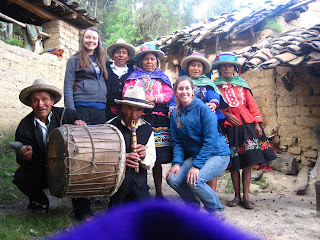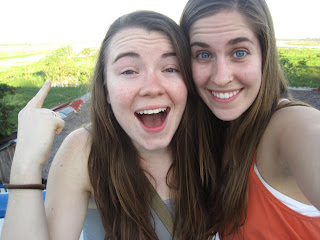My first two weeks here in Peru has almost passed and so many things have happened it feels like I have been here for a month! Where to begin...
When Rylie, my friend from high school and current traveling buddy, and I decided to take this trip to South America I don't think we realized what we were getting into when we bought our tickets only three weeks before leaving. A lot of time was dedicated to planning as much as we could while leaving room for flexibility and I came into this country with little expectations. Of those expectations I had, they were completely blown away by how amazingly different life is here.
I lived in Costa Rica for two months and there are things here in Peru that remind me of Central America but it still is so unique in it´s own way. It is also very different traveling from start to finish with a friend, I have someone to laugh with at every crazy and funny thing that happens here.
We flew into Lima and spent three days wandering the city, riding the bus, eating a lot of great food and meeting locals. Fortunately, Rylie´s Peruvian cousin, Inez lives in Lima and became our loving guide and friend. She took us around to various places, introduced us to her friends and gave us a lot of priceless advice. Our hostel was warm and welcoming and sat one street away from the postcard picture cliffs that line the city´s ocean border.
Almost every city in Peru is dotted with plazas and our first experience with one was in Barraco, La Plaza de Barrancos, one district away from where we were staying. There were giant sparse trees, brightly colored buildings, (a library and a chruch), and a cobblestone ground peppered with occupied park benches. It was just another evening in the city, kids were playing by the fountain, couples were strolling and families were passing time without a care in the world. This is something I love about this culture. People here have an amazing way of simply enjoying the moment and the people they are with.
After three fun days in Lima. We hopped on a small plane and headed Northeast towards Iquitos, a jungle city only reached by plane or boat. We arrived in the evening and when exiting the plane, I felt humidity like I never have before! It is so humid here, you want to take a shower 10 minutes after you dry off from one. We could immediately tell we were in the jungle, surrounded by trees and plants, hearing insects and smelling a very earthy smell.
In the past 8 days I have been here, I have grown to love this place. Rylie and I are living with the Pastor of a church and his family in the city. He also owns two Christian Schools where Rylie and I both work in exchange for a place to live. We are the English teachers assistants. She is at one school and I am at the other. Last week (our first week), we worked with the kindergarten and first grade class rooms. There is no better way to lighten up your morning than to have 20 little Peruvian children in uniforms run to the door with arms wide open when you enter. This next week I will be working with the older kids to vary my experience and help other students. I really enjoy teaching English and might consider it a profession in my future.
There are countless things about Iquitos that are so far from my life back home in Washington. For example, people here do not have cars. If they own any form of transportation, it is a plastic, Suzuki motorbike. I see women driving to work in the mornings in business suits with 4 inch heels on their speedy little bikes. You can also find families of 5 all piled together on one bike. Way to carpool! A great number of people here without a motorbike use the ¨moto-carro¨. These are half motorcycle half 3-person buggy on two wheels, making this a little 3-wheel buzzing taxi you would only see in the movies or here in the jungle... They swarm the streets like buzzing bees and pay no respect to the lines on the road or the pedestrians crossing the street. You can forget crosswalks for the most part here but don´t worry Mom, I am completely safe. They beep their horns every few seconds and drive within inches from the next vehicle over. A ride in a motocarro never gets old!
Here in Peru, the currency is called a ¨sol¨or ¨soles¨ in plural form. The U.S. dollar is $1 to 2.7 soles. So things here are rather inexpensive. For 2 soles, you can buy the sweetest, juiciest mango along the street, a 10 minute taxi ride, a lunch special, or an hour of internet use.
The food here is interesting...It can be hard to be a pescatarian at some places unless I want a whole fish on my plate from head to tail. And to be honest, I have eaten a little chicken to keep the meals interesting. Here they eat a lot of fried plantains, corn,meat and white rice. My favorite authentic meal here so far is called Tacu Tacu. It´s a mixture of rice and pinto beans all mixed together with spices and typically comes with a fried plantain. It really hits the spot. As far as drinks, we drink a lot of Jugo de Maracuya or ¨passion fruit juice¨. When blended with ice and fresh from the tree, it´s the best way to cool off in the afternoons.
Our typical Monday-Friday looks a bit like this...
7am - wake up and get ready for school
8am - start school
1pm - exhausted from school and head home, eat something, take a nap, shower
4pm - venture to the main plaza, explore, drink jugo de maracuya, use the internet, meet random people who become friends, explore some more, meet up with friends, find a place for dinner, journal and walk along the boardwalk that lines the Nanai River
11pm - get home, kill some cockroaches, get ready for bed and fall asleep to the sound of summer crickets along with mice scratching on the tin rooftop. Not the best sound ever but at least I have a room for free right? There are many details left unwritten you get the idea.
Some interesting observations:
The family we are living with has 2 dogs, 3 puppies, a pregnant cat, 2 tortoises, and a hen all living amongst each other in the backyard (except for the cat). The tortoises and hen will be a future supper sadly.
Most of the people we meet here have lived here their whole lives and don´t feel a desire to ever leave.
The boys and men here must think its flattering for a gringa (white girl)to be whistled at constantly. If I got one sol for every whistle, my trip would already be paid for.
Yesterday we explored the 17 acre ranch the family owns. Unfortunately, it took about 7 kilometers in the sweltering sun to get there and back. It was great to try the guava, papaya and other foreign fruits fresh from the trees. It came with a price though...countless mosquito bites and a sunburn.
Today was the first day we explored an area called Nanai, it was bustling with a local market of fresh and grilled food and sits right along the Nanai River. We took a long wooden boat 20 minutes to a town called Padre Cochas, an town of Native people. They live the same as the people in the city but it is a much smaller town with quaint roads about 7 feet wide. Our boat driver, an 18-year-old native of Padre Cochas named Max took us around the village. People live so simply here it amazes me. To have so little material possessions and live a happy life reminds me what I should value in life. Its about the people and experiences, not about how much I own.
God is doing amazing things here and he has his hand over Rylie and I. This whole time we have been discovering new things about God and this place. I have also been discovering things about myself. About what I value in life and how I want to live it. He is teaching me that love comes in so many languages, whether spoken or through actions, big or small, I have been inspired.
Until next time...
Hasta luego!













